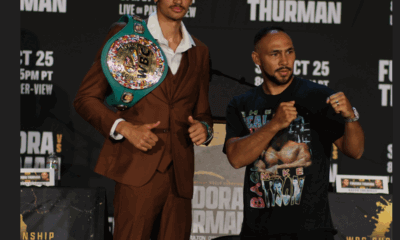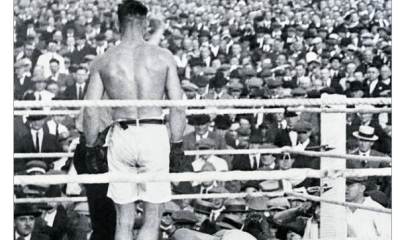Asia & Oceania
As The Boxing World Turns: The Reflections of a Man Who Went Home Again
REFLECTIONS — They say you can never go home again, a phrase that harks to “You Can’t Go Home Again,” the title of Thomas Wolfe’s famous 1940 novel. We can’t recapture our lost youth because things are never as they were. In life the only constant is change.
This reporter put Wolfe’s dictum to the test in 2016. After being out of the loop for a period of roughly 12 years, I came back to boxing. And one thing I learned about going home again is that one sees and feels things that would not have registered if the cord hadn’t been broken. It takes a fresh set of eyes to appreciate all that has changed.
A little background. In 1983, I attended my first fight in which I was equipped with a press credential. Here in Las Vegas, I wrote for a weekly tabloid and co-hosted a weekend sports talk radio show. That entitled me to sit up close at fights big and small and rub elbows with some of the best sportswriters in the country. Then the tabloid folded and I lost my radio gig and, presto, I was back to being a civilian. If I wanted to go to a fight, I had to buy a ticket.
I stopped going to the big fights even though many of them were right here in my backyard. Moreover, I was highly selective in purchasing a pay-per-view event. Call me a fair-weather fan, perhaps the shoe fits, but for me the actual fights were never as enticing as the chance to hobnob with some of my favorite writers, men like Jim Murray and Dick Young and Bert Sugar, all now sadly gone. You can’t get that from the TV.
Flash forward to January of 2016. Given the opportunity to succeed the talented Michael Woods as editor of The Sweet Science, I channeled the great referee Mills Lane and said “let’s get it on.” And just like that I was back in good graces with the gatekeepers that dole out press passes. I was Rip Van Winkle returning to Sleepy Hollow.
What changed while I was gone?
When I walked away from boxing, the digital age was well underway, but my memories are of an earlier era, an era when newspaper correspondents cribbed notes on a notepad and then dashed to the room that held all the electric typewriters to hammer out their post-fight stories. Nowadays, with news providers under greater pressure to eliminate the lag time in disseminating information, a laptop is as indispensable as a hammer is to a carpenter. However, it says here that the old-timers who worked in what is now called the print media wrote better stories.
When I leave the house, I carry a smart phone, an aptly named gadget as it is a lot smarter than me. Who would have ever thought that something so small could perform so many functions?
At pre-fight and post-fight confabs, one now sees correspondents using their smart phone as a recording device. There’s a downside.
We have all seen movies where a gaggle of reporters corners an interview subject and badgers him with questions. That’s still a common sight. However, a man using his smart phone as a recording device expects his colleagues to back off so they don’t spoil the audio with extraneous noise. That’s not very efficient and it tries the patience of the interviewee who will be splayed with many of the same questions, again and again, if he has the patience to accommodate everyone. In this regard, here’s a raspberry for the heavy-set fellow with the fuzzy hair: I could have read War and Peace in the time that it took you to complete your interview. Speed it up, pal, and show a little consideration for the folks waiting in line behind you.
Glitz and Glamour
Boxing events in Las Vegas became louder and glitzier during my absence as the sweet science followed the drift of other sports, a development I suspect was set in motion with the inception of giant video screens at professional sports stadiums. At the MGM Grand Arena, the laser light show is nice and the short film of great moments from great fights is terrific, but this old-school reporter would prefer a little less noise. The cynical bone in me thinks that the razzmatazz gives promoters less incentive for putting on good fights. Enhancing the overall “entertainment experience” becomes the larger priority.
In Las Vegas, the entertainment experience commences before the day of the fight. When the principals in a mega-fight arrive at the host property, they literally get the red carpet treatment. The paparazzi are there to capture the moment. The weigh-in is a major affair.
Here too boxing has followed the drift of other sports. The NBA All-Star Game and the baseball All-Star Game long ago stopped being stand-alone events. They are the cornerstones of many-sided fan fests.
Weigh-Ins
In this reporter’s lifetime, no weigh-in attracted as much curiosity as the weigh-in for Larry Holmes first fight with Michael Spinks. All eyes were on Spinks who was leapfrogging the cruiserweight division and would come in at a well-sculpted 200 pounds, twenty-five pounds more than he weighed in his previous bout. But while Spinks’ weight was a hot topic of conversation, there weren’t more than a few dozen people on hand to witness his weigh-in. No one had yet envisioned that the sight of a man stepping onto a scale in his underpants could be contorted into a public spectacle.
The weigh-ins for Manny Pacquaio’s most recent fight were conducted before a packed house on the stage of the largest showroom at the Wynn and live-streamed around the world on the Internet. As an indication of the gravity of the event, globetrotting ring announcer Michael Buffer handled only the major bouts, leaving the introductions of the “lesser acts” to a local man, as is his custom. Admission was free, but there was money to be made from concession and souvenir sales and parking fees.
Sponsorships
The peripheral events give sponsors added exposure, a useful chit in pursuing their patronage. The folks behind Tecate beer reputedly ponied up $5.6 million to be the official sponsor of the Pacquiao-Mayweather fight. The sponsors for Bob Arum’s last big Las Vegas show included ANTA, the leading manufacturer of sports apparel in China.
With more sponsorship dollars filtering into boxing than ever before, tracking the money to determine whether a show was profitable just became a lot more difficult. Pay-per-view numbers, the established way of judging whether a big fight was a commercial success, are slowly becoming a smaller piece of the puzzle.
An annoying byproduct is that ring introductions have become more long-winded as ring announcers roll off the names and catchphrases of the various sponsors. When it comes to being inundated with advertisements, however, boxing fans sure get off easy. Have you ever listened to a New York Yankees baseball game on the radio? My goodness, there’s an ad for every circumstance, no matter how uncommon. Jumbo Watson limbering up in the on-deck circle just scratched his balls. And fans, that’s our Gold Bond Rapid Relief Anti-Itch Cream moment. When you’re itching like crazy, choose Gold Bond. (Okay, I made that one up.)
Alphabet Soup
When I left boxing, I left behind a community of writers and fans who, like their forebears, were perpetually disgruntled at the way the sport was being run. Of the many things that hackled them, none was as aggravating as the proliferation of world title belts.
I was not so obtuse as to think that “alphabet soup” was a phase destined to fade away. However, I thought something of a ceiling had been reached. The folks that run the various sanctioning bodies couldn’t possibly fragment the framework any more than they already had. But while I was away, they proceeded to do exactly that. Ugh.
A quick glance at the current WBA ratings reveals that the organization now recognizes three world cruiserweight champions. There’s the WBA Super World Champion (Denis Lebedev), the WBA “regular” World Champion (Beibut Shumenov), and the WBA Interim World Champion (Yunier Dorticos). Five lower weight classes are carved up the same way. The WBA denominates Andre Ward the undisputed 175-pound world champion. But they also recognize Nathan Cleverly as their light heavyweight champion. Go figure.
Then there are the fringe organizations like the Universal Boxing Federation which recognizes Henry Lundy as the world lightweight champion. Lundy acquired the title by outpointing John Delperdang (say who?) in a bout held in a Cincinnati fitness studio.
Actually, the fringe organizations never bothered me. They have been around forever. However, in the last few years there’s been a push by the major sanctioning bodies to extend the scope of regional title fights to include 8-round bouts and, as a traditionalist, I find that more than a little disturbing. We seem to be on a path where every fight will have some sort of title attached to it, no matter the number of rounds or the skill level of the participants.
Here’s my dilemma: If I’m doing a ringside report, do I acknowledge tinhorn labels in my story or ignore them? Back in September, I saw a young fighter from California named Neeco Macias deliver a rousing good performance in an undercard bout on a show at the Downtown Las Vegas Events Center. Should I have noted in my post-fight story that the 8-round match was contested for the vacant WBC United States North American Boxing Council super welterweight title? For the record, I did not, but I’m not sure I did the right thing and I welcome your suggestions. Do I acknowledge a dubious imprimatur – thereby giving more encouragement to the alphabet soup bandits — or do I simply ignore it?
Eye Candy
While I was away from boxing — and mind you, I’m not complaining — the bottom portion of the ring card girls attire at the smaller Las Vegas shows got skimpier, exposing more skin in the posterior. I’m curious whether this is a passing fad, or whether it’s parcel of an evolution that will eventually see the ring card girls wearing little more than a G-string. This being Las Vegas, it seems reasonable to assume the latter.
—
In the last 12 months, I’ve witnessed unseemly behavior by ill-bred boxers and their associates at public forums and I’ve been astonished by some of the scorecards turned in by our blind ringside judges. This calls to mind another adage pertaining to our rapidly changing world: The more things change, the more they remain the same.
Check out more boxing news on video at The Boxing Channel.
-

 Book Review4 weeks ago
Book Review4 weeks agoMark Kriegel’s New Book About Mike Tyson is a Must-Read
-

 Featured Articles2 weeks ago
Featured Articles2 weeks agoThe Hauser Report: Debunking Two Myths and Other Notes
-

 Featured Articles3 weeks ago
Featured Articles3 weeks agoMoses Itauma Continues his Rapid Rise; Steamrolls Dillian Whyte in Riyadh
-

 Featured Articles3 weeks ago
Featured Articles3 weeks agoNikita Tszyu and Australia’s Short-Lived Boxing Renaissance
-

 Featured Articles4 weeks ago
Featured Articles4 weeks agoKotari and Urakawa – Two Fatalities on the Same Card in Japan: Boxing’s Darkest Day
-

 Featured Articles3 weeks ago
Featured Articles3 weeks agoIs Moses Itauma the Next Mike Tyson?
-

 Featured Articles4 weeks ago
Featured Articles4 weeks agoRamirez and Cuello Score KOs in Libya; Fonseca Upsets Oumiha
-

 Featured Articles2 weeks ago
Featured Articles2 weeks agoBoxing Odds and Ends: Paul vs ‘Tank,’ Big Trouble for Marselles Brown and More





















